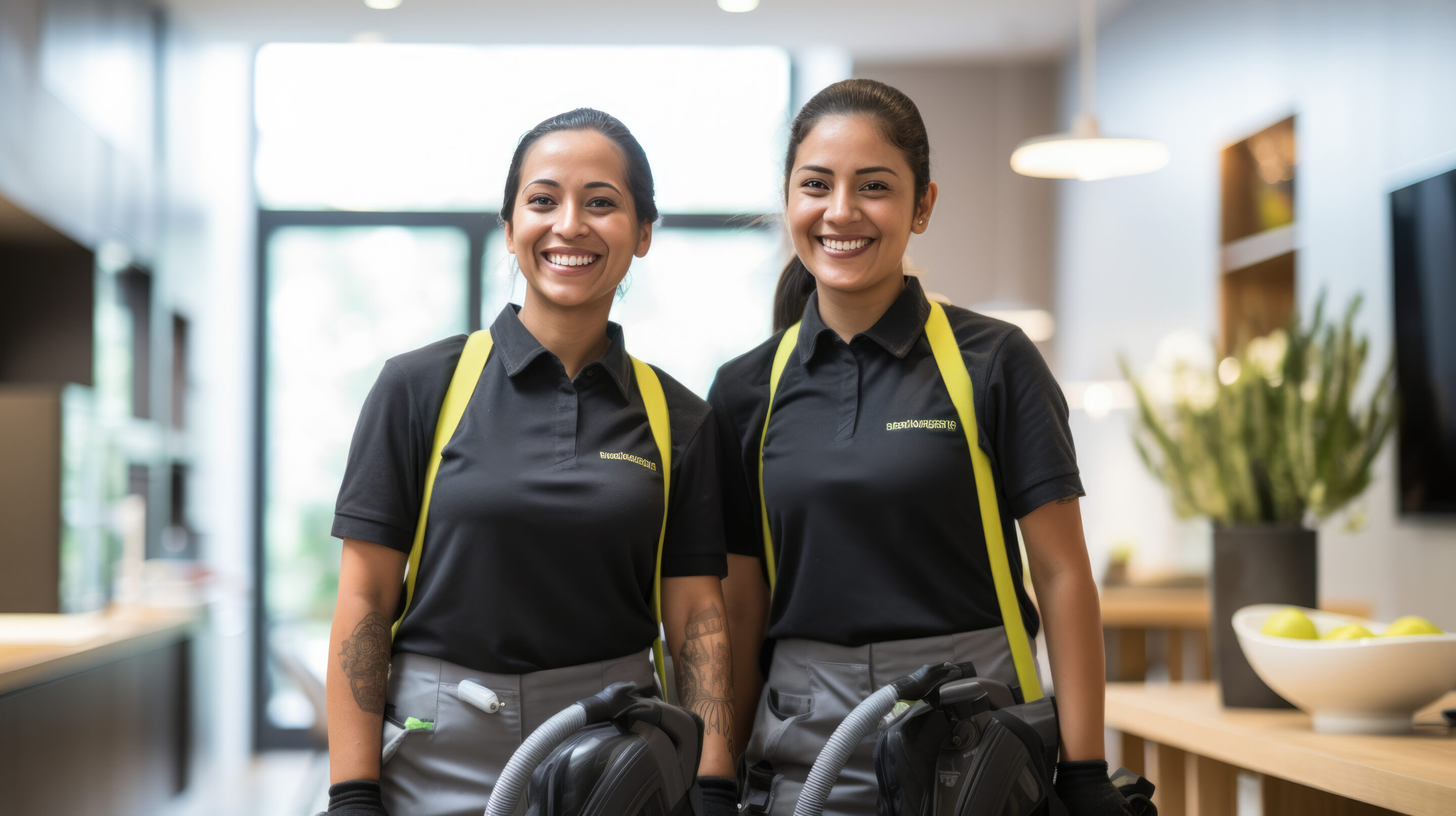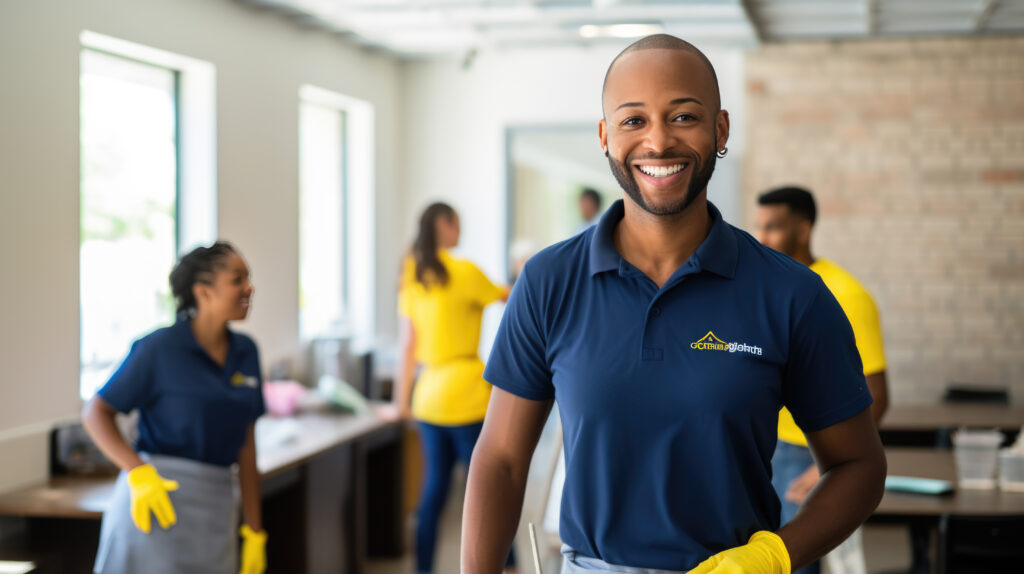“Research from Coventry University found that wearing a well-made, well-fitting uniform can make employees feel 22% happier at work, which in turn boosts productivity.” – Samantha Warren, Scrappy Apparel Company.
Work Uniforms play a key role in shaping a retail store’s image and setting the tone for memorable shopping experiences. Uniforms promote brand recognition and create a synergetic atmosphere in the workplace. When companies adopt well-designed employee uniforms, they enhance customer service and drive business success. In this article, we explore how work uniforms contribute to building a positive work environment and the strategic benefits uniforms offer employees and customers.
What is the purpose of an employee uniform?
Retail employee uniforms serve several functional purposes. For example, they enhance brand identity, provide free advertising, and improve security by clearly distinguishing employees from customers.
Uniforms create a sense of team spirit and professionalism, which can lead to better customer service and team collaboration. In Addition, uniforms save employees from the cost of work attire and contribute to a more consistent and professional company image.
Employee Uniforms Defined
The law firm Aiman-Smith & Marcy states that “Uniforms are legally defined as specific items of clothing that must be worn by employees in a particular location, and that can’t be worn by individuals in a specific profession no matter what establishment they choose to work for. Employers who require uniforms must reimburse their employees for them.”
What is the difference between a workplace dress code and a company uniform?
The main difference is that, unlike dress codes, work uniforms are standardized, and employers require employees to wear them during working hours. Employee uniforms project a sense of identity, unity and belonging among employees.
Five Ways Uniforms Can Improve A Store’s Image
There are several factors to consider when choosing an employee uniform. For instance, in the industry where the business operates, with the specific needs of the company’s employees, finding the perfect uniform is not easy. To assist employers in making prudent decisions, we’ve compiled a list of items to consider when designing and choosing a work uniform:
Defining Brand Identity
Work uniforms help establish and reinforce a retail brand’s identity using specific colors and logos. They make employees visible representatives of the brand, enhancing recognition and association in the customers’ minds. Uniforms also add visual consistency, ensuring the brand’s identity is coherent and memorable.
Unifying Store Aesthetic
Company uniforms contribute to the overall aesthetic and theme of a store, making the retail environment more appealing. What’s more, they make employees look and feel like part of the team and intended store environment. This alignment between employee appearance and store design creates a cohesive and attractive setting for shoppers.
Improving Role Recognition
Store Uniforms facilitate easy recognition of employees’ roles, helping customers and other staff members identify who to approach for specific needs. For example, different colors or designs can indicate various departments or managerial authority levels, streamlining interactions and service. This clarity in roles can improve operational efficiency and customer satisfaction.
Projecting Professionalism
Uniforms signal professionalism and serve as a visual commitment to quality and service. They also help shoppers distinguish between employees and customers. Uniforms set a standard of appearance that reflects the store’s values and work ethic. This professional image can build customer trust and respect, enhancing their perception of the store.
Keeping Employees Safe & Regulation Compliant
Uniforms can also play a crucial role in employee safety, especially in environments with physical risks. For instance, uniforms can include protective gear and are often designed to meet regulatory safety standards. In short, uniforms demonstrate a store’s commitment to maintaining a secure workplace for team members.
Characteristics of A Professional Retail Store Uniform
Here are five characteristics of a well-designed retail store uniform and the reasons why they are important:
Proper Fitting
A well-fitted uniform ensures that employees are comfortable and confident, which reflects positively on their performance and interactions with customers. Proper fitting enhances the professional appearance of staff, making the retail environment more appealing. It also encourages employees to wear their uniforms proudly as they represent the brand.
Color and Brand Identity
Using consistent and strategic colors in uniforms helps reinforce brand identity and aids customers in recognizing staff quickly. A uniform color scheme that aligns with the company’s branding creates a cohesive look, which strengthens the brand’s presence in the market. This visual unity supports marketing efforts by making the brand memorable.
Fabric Options
Choosing the suitable fabric for uniforms is crucial for durability and comfort. Fabrics should be selected based on the work environment and the physical demands of the job, ensuring that uniforms are suitable for daily wear and performance. High-quality, appropriate fabrics reduce discomfort and can withstand the rigors of retail tasks, maintaining a professional look longer.
Stylish and Fashionable
A modern and appealing uniform design increases employee satisfaction and pride in their appearance. Stylish uniforms make a positive impression on customers, projecting a forward-thinking and professional company image. Updating uniforms with contemporary designs can also make the brand more attractive to a broader demographic.
Functionality
Uniforms should be designed with functionality in mind so that employees can perform their tasks comfortably and without hindrance. Features such as pockets, durable materials, and appropriate fits specific to job roles can enhance the effectiveness of the uniform. Functional uniforms reduce constraints on movement and accommodate various physical activities, which is key in a dynamic retail environment.
Retail Stores that Require Employees to Wear Uniforms
Here are three retail stores that use uniforms, the reasons they use them, and specific examples that demonstrate how the uniforms have achieved their intended purposes:
Walmart
Walmart uses uniforms to create a consistent and recognizable appearance for all its employees, facilitating easy identification by customers in their large store layouts.
Example: Walmart’s use of blue vests with a yellow Walmart logo has become a recognized symbol of their brand. This uniform helps customers quickly identify who to approach for assistance, enhancing customer service and streamlining the shopping experience.
Target
Target uses uniforms to enhance brand identity and project a professional retail environment. Their distinctive red and khaki uniform reinforces the Target brand and differentiates their staff from customers.
Example: The red and khaki color combination of Target’s uniforms makes employees easily visible to customers and reinforces the brand’s image. Customers have reported feeling more confident approaching staff for help, indicating the uniform’s role in improving customer interactions and service efficiency.
Starbucks
Starbucks uses its dress code to maintain a consistent aesthetic that complements its coffeehouse’s atmosphere and ensures that baristas appear professional and approachable.
Example: Starbucks introduced green aprons as part of its uniform to match its logo and emphasize its commitment to quality coffee. These uniforms assist in maintaining a cohesive brand image across global locations, and customers have noted the approachability and professionalism that the baristas exhibit, which aligns with the company’s customer service goals and values.
Home Depot
Home Depot uses uniforms to create a sense of professional authority and knowledge among employees, making it easier for customers to seek advice and help navigating the extensive product range in their large warehouse-style stores.
Example: Home Depot’s employees wear orange aprons, which resonate with the store’s brand color and make them highly visible among the aisles of products. This visibility has proven effective as shoppers can find assistance quickly, leading to better customer experiences and efficiency in finding products.
McDonald’s
McDonald’s uses employee uniforms to promote a clean, professional image that reflects its fast-food service standards. The company’s uniforms also help maintain hygiene and safety standards, which are crucial in the food service industry.
Example: McDonald’s uniform includes a polo shirt and cap branded with the McDonald’s logo, demonstrating brand consistency and recognition. This professionally styled attire has helped maintain a uniform standard of service across McDonald’s franchises globally, ensuring that employees are easily identifiable and approachable by customers.
What can we learn from successful companies?
Work Uniforms serve as a practical tool for businesses to enhance brand recognition and create a consistent image. They make employees easily identifiable, improving customer service by helping them find assistance quickly.
Uniforms also promote professionalism and unity among staff, contributing to a positive work environment. Moreover, comfortable and functional uniforms improve employee morale and productivity, as employees feel confident and proud to represent their company.
Tips for Businesses Introducing Work Uniforms
- Implement uniforms that reinforce your brand identity with consistent colors and logos.
- Design uniforms to unify the store aesthetic and enhance the shopping environment.
- Use uniforms to clearly distinguish employee roles, improving customer service efficiency.
- Provide professional uniforms to project store values and build customer trust.
- Ensure uniforms include safety features to protect employees and meet regulatory standards.
“When employees wear uniforms, it conveys a sense of responsibility and dedication to the job, which reflects positively on the business.” (Source: Modern Retail)
Final Thoughts
Work uniforms continue to play a vital role in shaping the identity and functionality of retail environments. Uniforms not only enhance brand recognition and employee pride but also facilitate better customer interactions and service efficiency. When retail employers invest in thoughtful uniform design, they can create a more cohesive and professional atmosphere that benefits employees and customers.
Thank you for reading our article!
TimeWellScheduled is a secure online time and attendance software 100% tailored to meet your scheduling needs! In Addition, our cloud-based scheduling solution optimizes employee attendance tracking, simplifies payroll administration, and enhances staff management capabilities. Plus, our service is free for up to 10 employees!
Click here to download our (Excel) employee scheduling template; It’s free!






